.
2.04.2016
Comet 67P presented in silhouette
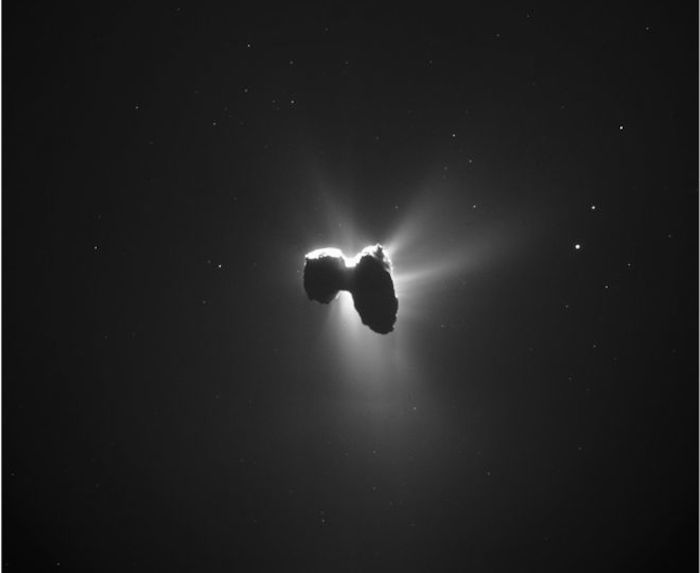
Perfectly backlit by our star. This is how Comet 67P was pictured this week by the Rosetta spacecraft.
The European Space Agency (Esa) probe was a few hundred km "downstream" of all the vapour and dust being vented from the icy dirt-ball.
Even though the duck-shaped object is heading out of the inner Solar System, it remains classically active.
Rosetta will continue to study the comet until controllers direct it to make a "landing" in September.
Mission officials will endeavour to make this touchdown a gentle one, to ensure data is returned for as long as possible. But it will bring the whole venture to an end.
Rosetta will likely be damaged by the impact and drop all contact with Earth.
In the meantime, scientists hope to gather as much information as they can about the 4km-wide wanderer.
Current observations are telling them about the workings of the tail of material that is carried away from 67P on the solar wind.
This latest image was acquired by Rosetta's navigation camera system. The comet and probe are currently just over 400 million km from the Sun, and receding at 20km per second.
.
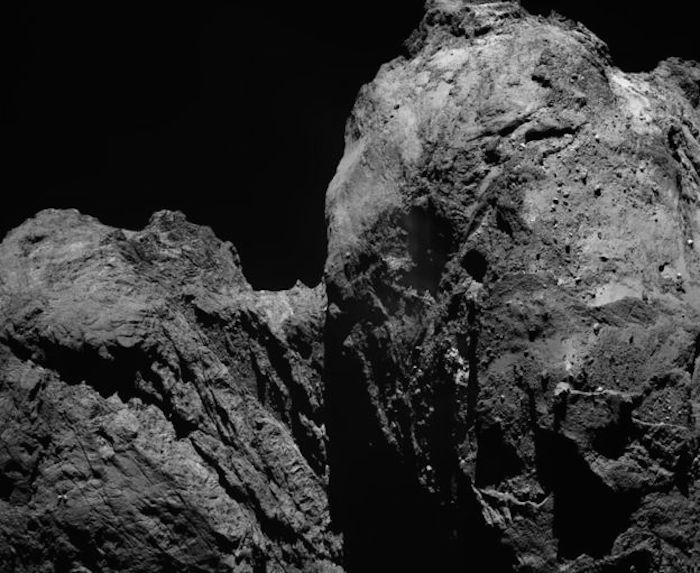
Since its launch in 2004, Rosetta has travelled 7.7 billion km, passing close by Mars and two asteroids on its way out to meet 67P.
The spacecraft arrived at the comet in August 2014, and dropped the Philae robot on its surface in November of that year.
67P's closest approach to the Sun, just inside the orbit of Mars, occurred on 13 August last year.
As the comet and probe now move back out towards the orbit of Jupiter, the amount of power Rosetta can generate from its solar panels will become increasingly limited.
Esa officials see no point in putting the probe to sleep in the hope it could come back to life when lighting conditions improve on 67P's next visit to the inner Solar System.
A more fitting end for the mission, they believe, is to get some spectacular close-up images in a bump-down landing.
.
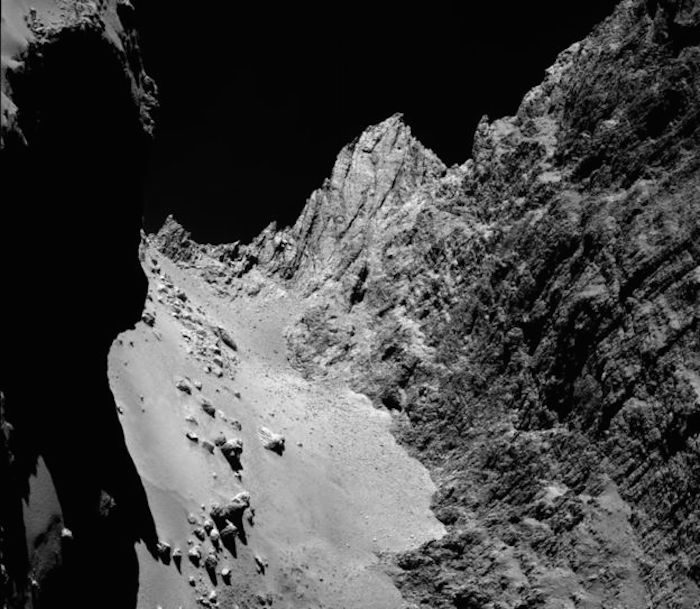
Quelle: BBC
-
Update: 28.05.2016
.
ROSETTA’S COMET CONTAINS INGREDIENTS FOR LIFE
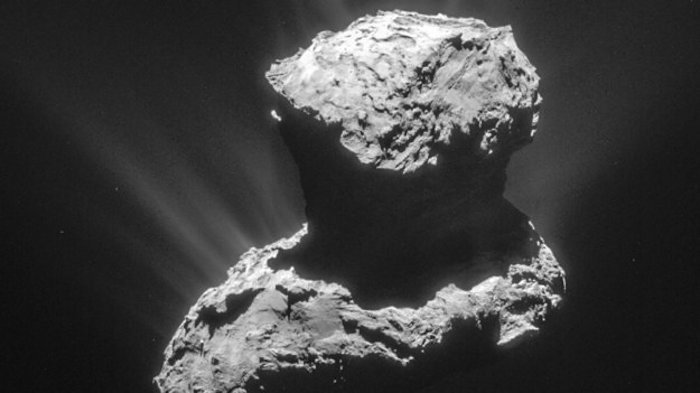
-
Ingredients regarded as crucial for the origin of life on Earth have been discovered at the comet that ESA’s Rosetta spacecraft has been probing for almost two years.
They include the amino acid glycine, which is commonly found in proteins, and phosphorus, a key component of DNA and cell membranes.
Scientists have long debated the important possibility that water and organic molecules were brought by asteroids and comets to the young Earth after it cooled following its formation, providing some of the key building blocks for the emergence of life.
While some comets and asteroids are already known to have water with a composition like that of Earth’s oceans, Rosetta found a significant difference at its comet – fuelling the debate on their role in the origin of Earth’s water.
But new results reveal that comets nevertheless had the potential to deliver ingredients critical to establish life as we know it.
.
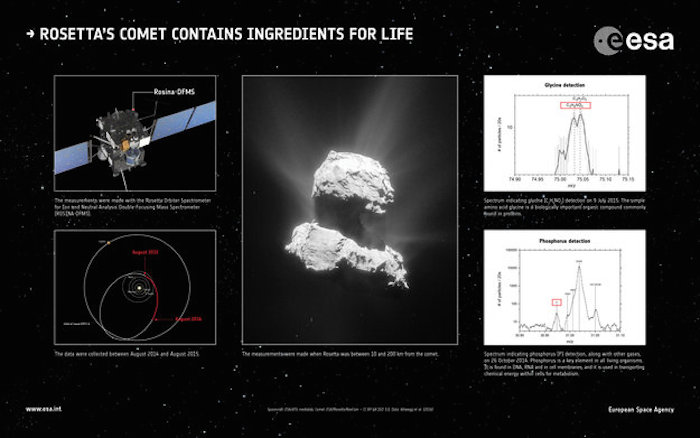
Rosetta’s comet contains ingredients for life
-
Amino acids are biologically important organic compounds containing carbon, oxygen, hydrogen and nitrogen, and form the basis of proteins.
Hints of the simplest amino acid, glycine, were found in samples returned to Earth in 2006 from Comet Wild-2 by NASA’s Stardust mission. However, possible terrestrial contamination of the dust samples made the analysis extremely difficult.
Now, Rosetta has made direct, repeated detections of glycine in the fuzzy atmosphere or ‘coma’ of its comet.
“This is the first unambiguous detection of glycine at a comet,” says Kathrin Altwegg, principal investigator of the ROSINA instrument that made the measurements, and lead author of the paper published in Science Advances today.
“At the same time, we also detected certain other organic molecules that can be precursors to glycine, hinting at the possible ways in which it may have formed.”
The measurements were made before the comet reached its closest point to the Sun – perihelion – in August 2015 in its 6.5 year orbit.
The first detection was made in October 2014 while Rosetta was just 10 km from the comet. The next occasion was during a flyby in March 2015, when it was 30–15 km from the nucleus.
Glycine was also seen on other occasions associated with outbursts from the comet in the month leading up to perihelion, when Rosetta was more than 200 km from the nucleus but surrounded by a lot of dust.
“We see a strong link between glycine and dust, suggesting that it is probably released perhaps with other volatiles from the icy mantles of the dust grains once they have warmed up in the coma,” says Kathrin.
Glycine turns into gas only when it reaches temperatures just below 150°C, meaning that usually little is released from the comet’s surface or subsurface because of the low temperatures. This accounts for the fact that Rosetta does not always detect it.
Quelle: ESA
.
Update: 30.05.2016
.
ROSETTA’S COMET CONTAINS INGREDIENTS FOR LIFE
-
Ingredients regarded as crucial for the origin of life on Earth have been discovered at the comet that ESA’s Rosetta spacecraft has been probing for almost two years.
They include the amino acid glycine, which is commonly found in proteins, and phosphorus, a key component of DNA and cell membranes.
Scientists have long debated the important possibility that water and organic molecules were brought by asteroids and comets to the young Earth after it cooled following its formation, providing some of the key building blocks for the emergence of life.
While some comets and asteroids are already known to have water with a composition like that of Earth’s oceans, Rosetta found a significant difference at its comet – fuelling the debate on their role in the origin of Earth’s water.
But new results reveal that comets nevertheless had the potential to deliver ingredients critical to establish life as we know it.
Amino acids are biologically important organic compounds containing carbon, oxygen, hydrogen and nitrogen, and form the basis of proteins.
Hints of the simplest amino acid, glycine, were found in samples returned to Earth in 2006 from Comet Wild-2 by NASA’s Stardust mission. However, possible terrestrial contamination of the dust samples made the analysis extremely difficult.
Now, Rosetta has made direct, repeated detections of glycine in the fuzzy atmosphere or ‘coma’ of its comet.
“This is the first unambiguous detection of glycine at a comet,” says Kathrin Altwegg, principal investigator of the ROSINA instrument that made the measurements, and lead author of the paper published in Science Advances today.
“At the same time, we also detected certain other organic molecules that can be precursors to glycine, hinting at the possible ways in which it may have formed.”
The measurements were made before the comet reached its closest point to the Sun – perihelion – in August 2015 in its 6.5 year orbit.
The first detection was made in October 2014 while Rosetta was just 10 km from the comet. The next occasion was during a flyby in March 2015, when it was 30–15 km from the nucleus.
Glycine was also seen on other occasions associated with outbursts from the comet in the month leading up to perihelion, when Rosetta was more than 200 km from the nucleus but surrounded by a lot of dust.
“We see a strong link between glycine and dust, suggesting that it is probably released perhaps with other volatiles from the icy mantles of the dust grains once they have warmed up in the coma,” says Kathrin.
Glycine turns into gas only when it reaches temperatures just below 150°C, meaning that usually little is released from the comet’s surface or subsurface because of the low temperatures. This accounts for the fact that Rosetta does not always detect it.
Quelle: ESA
-
Update: 31.05.2016
.
ROSETTAS KOMET ENTHÄLT DIE BAUSTEINE DES LEBENS
-
Auf dem Kometen, der seit nunmehr fast zwei Jahren von der ESA-Raumsonde Rosetta untersucht wird, wurden Substanzen entdeckt, die für die Entstehung von Leben auf der Erde eine besondere Bedeutung haben.
Dazu gehört unter anderem die Aminosäure Glycin, die gewöhnlich in Proteinen vorkommt sowie Phosphor als Schlüsselelement der DNS und von Zellmembranen.
Seit geraumer Zeit diskutieren Wissenschaftler die Möglichkeit, dass Wasser und organische Moleküle durch Asteroiden auf die nach ihrer Entstehung noch junge Erde gelangten, als sie sich abkühlte. Diese Stoffe bildeten die Grundbausteine für die Entstehung von Leben.
Von einigen Kometen und Asteroiden wissen wir bereits, dass deren Wasserzusammensetzung der der Ozeane auf unserer Erde entspricht. Auf dem Kometen Tschurjumow-Gerassimenko wurde mit Rosetta nun jedoch eine Abweichung hiervon festgestellt, was die Debatte um die Bedeutung der Herkunft des Wassers auf unserer Erde erneut entfacht. Doch neue Ergebnisse zeigen, dass Kometen trotzdem potentielle Lieferanten von "Lebenselementen" gewesen sein könnten.
Kometen könnten Lieferanten von Bausteinen des Lebens gewesen sein
Aminosäuren sind essentielle organische Verbindungen aus Kohlenstoff, Sauerstoff, Wasserstoff und Stickstoff. Sie bilden die Grundlage für Proteine.
Spuren der einfachsten Aminosäure, Glycin, konnten in Proben nachgewiesen werden, die 2006 im Rahmen der Stardust-Mission der NASA vom Kometen Wild-2 zur Erde zurückgebracht wurden. Durch die potentielle Kontaminierung der Proben auf der Erde gestalteten sich die Analysen jedoch äußert schwierig.
Nun konnten mit Rosetta zum wiederholten Male Spuren von Glycin in der Koma des Kometen nachgewiesen werden.
“Dies ist der erste unzweifelhafte Nachweis von Glycin auf einem Kometen”, stellt Kathrin Altwegg fest, Forschungsleiterin des ROSINA-Instruments, mit dem die Untersuchungen durchgeführt wurden und Chefautorin der neuesten Veröffentlichung in Science Advances vom 27. Mai.
“Gleichzeitig haben wir auch weitere organische Moleküle entdeckt, die Vorläufer von Glycin sein können und die auf mögliche Bildungsarten von Glycin hinweisen,” so Altwegg weiter.
Die Untersuchungen fanden statt, bevor der Komet der Sonne auf seinem sechseinhalb Jahre dauernden Orbit im August 2015 am nächsten stand – im Perihel.
Zum ersten Mal konnten Aminosäuren im Oktober 2014 ermittelt werden, als Rosetta sich in einer Entfernung von 10 km zum Kometen befand. Anschließend wurden sie im März 2015 bei einem Vorbeiflug in einer Entfernung von 30-15 km vom Kometenkern nachgewiesen.
Glycin kann sich auch ohne flüssiges Wasser bilden
Glycin war auch zu anderen Gelegenheiten messbar, als es in dem Monat vor Perihel zu Ausbrüchen auf dem Kometen kam und Rosetta sich in einer Entfernung von über 200 km vom Kometenkern befand, jedoch von einer Menge Staub umhüllt war.
“Wir können eine enge Verbindung zwischen Glycin und dem Staub erkennen. Da liegt es nahe, dass es möglicherweise mit anderen flüchtigen Stoffen aus dem Eismantel der Staubkörnchen freigesetzt wird, wenn diese sich in der Koma erwärmen”, meint Kathrin Altwegg.
Glycin geht nur bei Temperaturen knapp unter 150°C in den gasförmigen Zustand über. Das bedeutet, dass aufgrund der niedrigen Temperaturen an der Kometenoberfläche oder auch im Untergrund nur wenig davon freigesetzt wird. Daher kann es Rosetta nicht immer erkennen.
“Glycin ist die einzige Aminosäure, von der wir wissen, dass sie sich auch ohne flüssiges Wasser bilden kann. Dass es gemeinsam mit seinen Vorläufermolekülen und dem Staub auftritt, legt die Vermutung nahe, dass es sich im Weltraum in den vereisten Staubkörnern oder durch das einstrahlende ultraviolette Licht bildet, bevor es für Milliarden von Jahren im Kometen gebunden und eingeschlossen wird”, ergänzt Kathrin.
Eine weitere aufregende Entdeckung von Rosetta, die in der Publikation beschrieben wird, ist Phosphor, ein Schlüsselelement aller lebenden Organismen. Es tritt beispielsweise als struktureller Bestandteil der DNS und auch in Zellmembranen auf. Es dient dem Transport chemischer Energie für den Zellstoffwechsel.
“Natürlich gibt es noch viele Ungereimtheiten bezüglich der chemischen Zusammenhänge auf der noch jungen Erde und eine riesige Lücke in der Evolutionsgeschichte zwischen der 'Lieferung' dieser Elemente durch Kometen und der Entstehung von Leben, die gefüllt werden will”, erläutert Co-Autor Hervé Cottin.
“Aber der wichtigste Punkt ist, dass Kometen sich in den vergangenen 4,5 Milliarden Jahren nicht wirklich verändert haben: sie gewähren uns einen direkten Zugriff auf einige der Zutaten, die vermutlich in der Ursuppe gelandet sind, aus der schließlich das Leben auf der Erde, wie wir es heute kennen, entstanden ist.”
“Die Vielzahl organischer Moleküle, die bereits von Rosetta erkannt wurden und die nun durch die aufregende Bestätigung der grundlegenden lebensspendenden Bestandteile, wie Glycin und Phosphor, ergänzt wird, bestätigt unsere Annahme, dass Kometen das Potential haben, die Schlüsselmoleküle für die chemische Evolution zu liefern”, sagt Matt Taylor, ESA-Forscher im Rosetta-Projekt.
“Eines der Hauptziele der Rosetta-Mission ist der Nachweis, dass Kometen Reservoirs und Transportmittel für primitives Material sind, über die diese lebensnotwendigen Zutaten zur Erde gelangt sind. Deswegen freuen wir uns so sehr über diese Forschungsergebnisse.”
Quelle: ESA
.
Purdue, CU-Boulder study shows how comets break up, make up
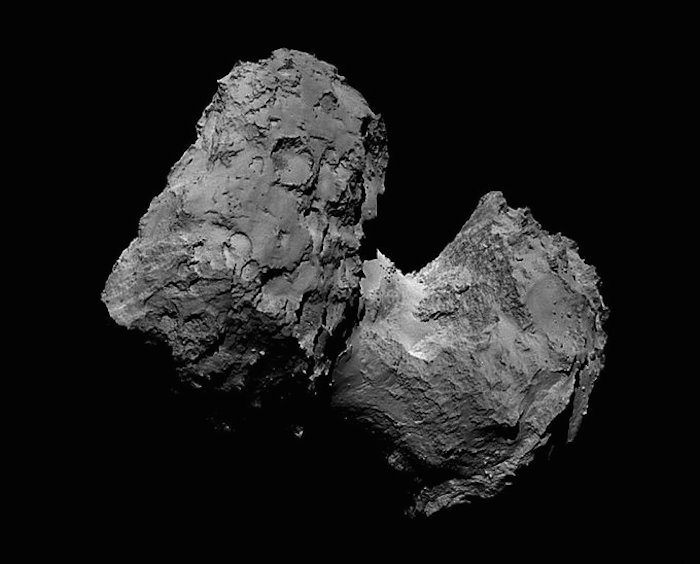
For some comets, breaking up is not that hard to do.
A new study led by Purdue University and the University of Colorado Boulder indicates the bodies of some periodic comets – objects that orbit the sun in less than 200 years – may regularly split in two, then reunite down the road.
In fact, this may be a repeating process fundamental to comet evolution, according to the study, which is being published in Nature on June 1.
The team, led by Purdue postdoctoral fellow Masatoshi Hirabayashi and CU-Boulder Distinguished Professor Daniel Scheeres, studied several comets, primarily a bizarre rubber duck-shaped object known as 67P/Churyumov-Gerasimenko (67P). Images of 67P show two cracks, each longer than an American football field, on the comet’s neck that connects its two larger lobes.
In order to reconstruct the past life of 67P, the team used numerical models in which the spin rate was cranked up from its roughly one rotation every 12 hours today to one rotation every 7 to 9 hours. The models showed the faster spin would lead to more stress and the formation of two similar cracks on the neck of 67P in the same location.
“Our spin analysis predicted exactly where these cracks would form,” said Scheeres of CU-Boulder’s aerospace engineering sciences department. “We now have a new understanding of how some comets may evolve over time.”
Often referred to as “dirty snowballs,” comets are made of ice, rocks and dust. Comet 67P is “bilobed” meaning it has two larger parts connected by a thinner neck.
Scheeres said there are several factors that can cause comet nuclei to spin faster. During flybys of the sun or Jupiter, for example, periodic comets like 67P can get torqued by gravity, causing them to either spin up or spin down. The spin also can be affected by periodic comet “outgassing,” when icy compounds like carbon dioxide and ammonia shift directly from a frozen state to gaseous state and blow off the surface.
The models run by the team showed that if 67P’s spin is increased to less than seven hours per rotation, the head will pop off, said Scheeres. So what happens then?
“The head and body aren’t going to be able to escape from each other,” he said. “They will begin orbiting each other, and in weeks, days or even hours they will come together again during a slow collision, creating a new comet nucleus configuration.”
This pattern could go on for the life of the comet, said Scheeres.
Bilobed comets may turn out to be fairly common. Of the seven comets that have been imaged in high resolution by astronomers, five of those – including P67 and Comet Halley – are bilobed, said Scheeres. Studies of the bilobed comets by the team indicate they all are similar in their volume ratios between each lobe, meaning they probably go through the same break-up/make-up cycles as 67P.
Discovered in 1969 and visited by the European Space Agency’s Rosetta spacecraft in 2014, 67P is roughly 2.5 miles on a side and orbits the sun every 6.5 years. The team showed that the comet’s spin rate can change chaotically, driven by outgassing events and its changing orbit due to flybys of Jupiter.
To show how this comet-sun interaction affected the past evolution of 67P’s spin period, the researchers numerically modeled 1,000 comet “clones” of 67P under varying conditions going back 5,000 years. Five thousand years was selected because it is the approximate lifetime of a “Jupiter family comet” like 67P, said Scheeres.
Periodic comets like 67P are thought to originate in the Kuiper Belt, a vast region beyond Neptune’s orbit harboring billions of comets and icy moons. The team hypothesized that the repeated break-up and make-up of bilobed comets may have caused them to erode too much to have survived their journeys into the inner solar system 4 billion years ago when it was a shooting gallery of asteroids, moons and protoplanets.
Other study authors include Assistant Professor Jay McMahon of CU-Boulder, Steven Chesley of the Jet Propulsion Laboratory in Pasadena and Simone Marchi of the Southwest Research Institute Planetary Science Directorate in Boulder. Purdue’s Hirabayashi received his doctorate at CU-Boulder under Scheeres in 2015.
Scheeres is the radio science team leader for NASA’s OSIRIS-Rex mission, now slated to launch in September from Florida to visit the near-Earth asteroid, Bennu.
Quelle: University of Colorado4480 Views
